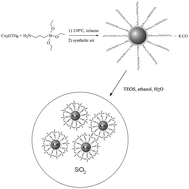A simple aminoalkyl siloxane-mediated route to functional magnetic metal nanoparticles and magnetic nanocomposites
Abstract
Magnetic

* Corresponding authors
a
Institut für Technische Chemie, Forschungszentrum Karlsruhe, D-76021 Karlsruhe, Germany
E-mail:
silke.behrens@itc-cpv.fzk.de
Fax: +49 7247 822244
Tel: +49 7247 826512
b Institut für Nukleare Entsorgung, Forschungszentrum Karlsruhe, D-76021 Karlsruhe, Germany
c Institut für Nanotechnologie, Forschungszentrum Karlsruhe, D-76021 Karlsruhe, Germany
d Max-Planck-Institut für Kohlenforschung, D-45470 Mülheim, Germany
Magnetic

 Please wait while we load your content...
Something went wrong. Try again?
Please wait while we load your content...
Something went wrong. Try again?
A. Gorschinski, G. Khelashvili, D. Schild, W. Habicht, R. Brand, M. Ghafari, H. Bönnemann, E. Dinjus and S. Behrens, J. Mater. Chem., 2009, 19, 8829 DOI: 10.1039/B911738E
To request permission to reproduce material from this article, please go to the Copyright Clearance Center request page.
If you are an author contributing to an RSC publication, you do not need to request permission provided correct acknowledgement is given.
If you are the author of this article, you do not need to request permission to reproduce figures and diagrams provided correct acknowledgement is given. If you want to reproduce the whole article in a third-party publication (excluding your thesis/dissertation for which permission is not required) please go to the Copyright Clearance Center request page.
Read more about how to correctly acknowledge RSC content.
 Fetching data from CrossRef.
Fetching data from CrossRef.
This may take some time to load.
Loading related content
